The Role of Brain Lesions in Neuropsychological Assessment: A Report
VerifiedAdded on 2023/06/01
|8
|3309
|287
Report
AI Summary
This report provides an in-depth analysis of the neuropsychological assessment of individuals with brain lesions, emphasizing the significant impact of brain pathology on cognitive and behavioral outcomes. It explores the rationale for studying patients with brain lesions, highlighting the importance of understanding the relationship between brain structure and function. The report discusses how neuropsychological assessments aid in identifying cognitive and memory deterioration, correlating findings with the extent of brain damage, and facilitating psychotherapeutic interventions. It also examines the benefits of studying patients with brain impairment, including the evaluation of personality changes and the identification of critical functions and comorbidity risks. The report also delves into the limitations of such studies, such as the challenges in precise lesion mapping and the masking effects of alternative behavioral processes. The report emphasizes the need for comprehensive assessments, including radiological interventions and the assessment of brain networks, to gain a deeper understanding of the complex neuropsychological mechanisms and their impact on overall brain function.
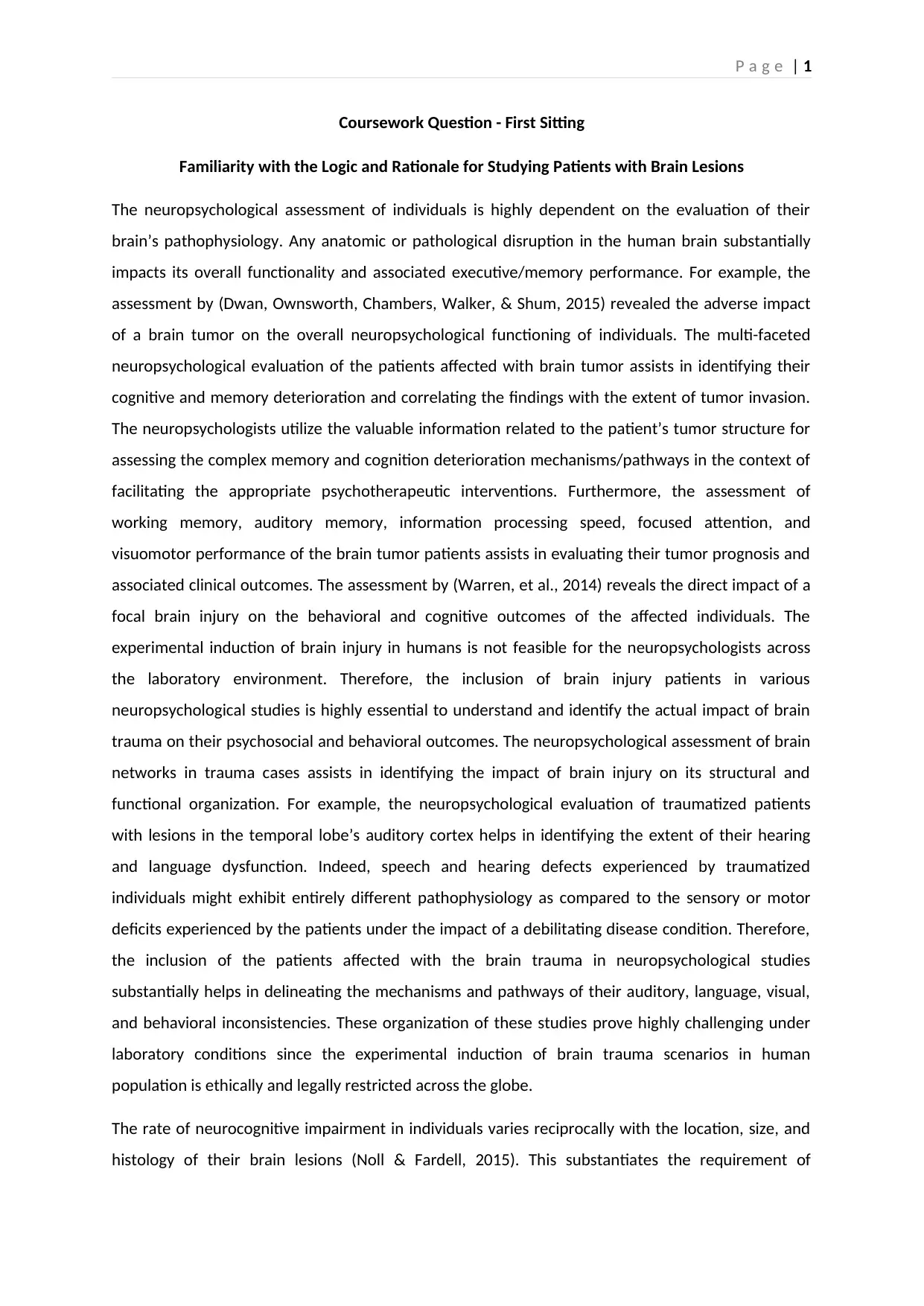
P a g e | 1
Coursework Question - First Sitting
Familiarity with the Logic and Rationale for Studying Patients with Brain Lesions
The neuropsychological assessment of individuals is highly dependent on the evaluation of their
brain’s pathophysiology. Any anatomic or pathological disruption in the human brain substantially
impacts its overall functionality and associated executive/memory performance. For example, the
assessment by (Dwan, Ownsworth, Chambers, Walker, & Shum, 2015) revealed the adverse impact
of a brain tumor on the overall neuropsychological functioning of individuals. The multi-faceted
neuropsychological evaluation of the patients affected with brain tumor assists in identifying their
cognitive and memory deterioration and correlating the findings with the extent of tumor invasion.
The neuropsychologists utilize the valuable information related to the patient’s tumor structure for
assessing the complex memory and cognition deterioration mechanisms/pathways in the context of
facilitating the appropriate psychotherapeutic interventions. Furthermore, the assessment of
working memory, auditory memory, information processing speed, focused attention, and
visuomotor performance of the brain tumor patients assists in evaluating their tumor prognosis and
associated clinical outcomes. The assessment by (Warren, et al., 2014) reveals the direct impact of a
focal brain injury on the behavioral and cognitive outcomes of the affected individuals. The
experimental induction of brain injury in humans is not feasible for the neuropsychologists across
the laboratory environment. Therefore, the inclusion of brain injury patients in various
neuropsychological studies is highly essential to understand and identify the actual impact of brain
trauma on their psychosocial and behavioral outcomes. The neuropsychological assessment of brain
networks in trauma cases assists in identifying the impact of brain injury on its structural and
functional organization. For example, the neuropsychological evaluation of traumatized patients
with lesions in the temporal lobe’s auditory cortex helps in identifying the extent of their hearing
and language dysfunction. Indeed, speech and hearing defects experienced by traumatized
individuals might exhibit entirely different pathophysiology as compared to the sensory or motor
deficits experienced by the patients under the impact of a debilitating disease condition. Therefore,
the inclusion of the patients affected with the brain trauma in neuropsychological studies
substantially helps in delineating the mechanisms and pathways of their auditory, language, visual,
and behavioral inconsistencies. These organization of these studies prove highly challenging under
laboratory conditions since the experimental induction of brain trauma scenarios in human
population is ethically and legally restricted across the globe.
The rate of neurocognitive impairment in individuals varies reciprocally with the location, size, and
histology of their brain lesions (Noll & Fardell, 2015). This substantiates the requirement of
Coursework Question - First Sitting
Familiarity with the Logic and Rationale for Studying Patients with Brain Lesions
The neuropsychological assessment of individuals is highly dependent on the evaluation of their
brain’s pathophysiology. Any anatomic or pathological disruption in the human brain substantially
impacts its overall functionality and associated executive/memory performance. For example, the
assessment by (Dwan, Ownsworth, Chambers, Walker, & Shum, 2015) revealed the adverse impact
of a brain tumor on the overall neuropsychological functioning of individuals. The multi-faceted
neuropsychological evaluation of the patients affected with brain tumor assists in identifying their
cognitive and memory deterioration and correlating the findings with the extent of tumor invasion.
The neuropsychologists utilize the valuable information related to the patient’s tumor structure for
assessing the complex memory and cognition deterioration mechanisms/pathways in the context of
facilitating the appropriate psychotherapeutic interventions. Furthermore, the assessment of
working memory, auditory memory, information processing speed, focused attention, and
visuomotor performance of the brain tumor patients assists in evaluating their tumor prognosis and
associated clinical outcomes. The assessment by (Warren, et al., 2014) reveals the direct impact of a
focal brain injury on the behavioral and cognitive outcomes of the affected individuals. The
experimental induction of brain injury in humans is not feasible for the neuropsychologists across
the laboratory environment. Therefore, the inclusion of brain injury patients in various
neuropsychological studies is highly essential to understand and identify the actual impact of brain
trauma on their psychosocial and behavioral outcomes. The neuropsychological assessment of brain
networks in trauma cases assists in identifying the impact of brain injury on its structural and
functional organization. For example, the neuropsychological evaluation of traumatized patients
with lesions in the temporal lobe’s auditory cortex helps in identifying the extent of their hearing
and language dysfunction. Indeed, speech and hearing defects experienced by traumatized
individuals might exhibit entirely different pathophysiology as compared to the sensory or motor
deficits experienced by the patients under the impact of a debilitating disease condition. Therefore,
the inclusion of the patients affected with the brain trauma in neuropsychological studies
substantially helps in delineating the mechanisms and pathways of their auditory, language, visual,
and behavioral inconsistencies. These organization of these studies prove highly challenging under
laboratory conditions since the experimental induction of brain trauma scenarios in human
population is ethically and legally restricted across the globe.
The rate of neurocognitive impairment in individuals varies reciprocally with the location, size, and
histology of their brain lesions (Noll & Fardell, 2015). This substantiates the requirement of
Paraphrase This Document
Need a fresh take? Get an instant paraphrase of this document with our AI Paraphraser
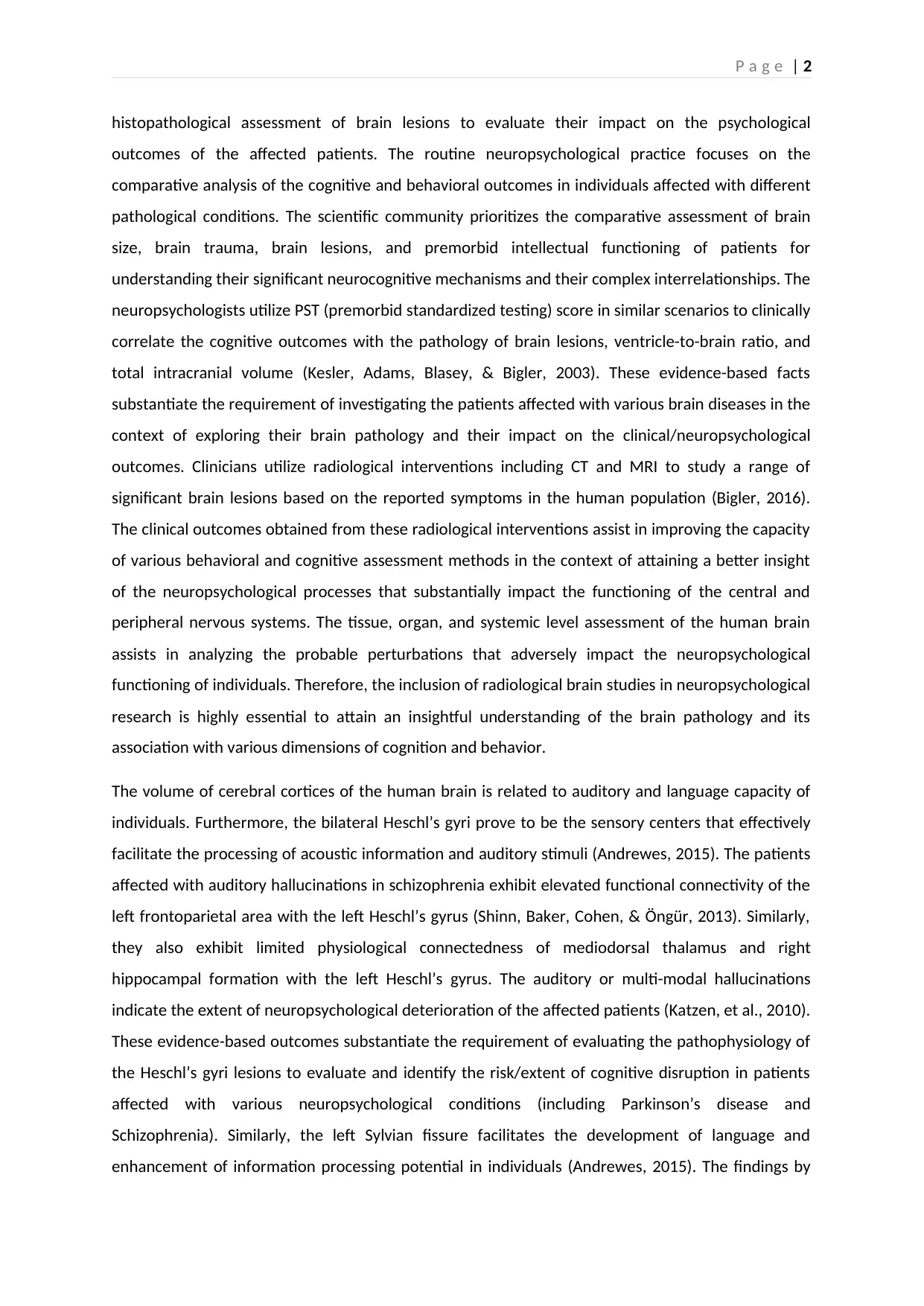
P a g e | 2
histopathological assessment of brain lesions to evaluate their impact on the psychological
outcomes of the affected patients. The routine neuropsychological practice focuses on the
comparative analysis of the cognitive and behavioral outcomes in individuals affected with different
pathological conditions. The scientific community prioritizes the comparative assessment of brain
size, brain trauma, brain lesions, and premorbid intellectual functioning of patients for
understanding their significant neurocognitive mechanisms and their complex interrelationships. The
neuropsychologists utilize PST (premorbid standardized testing) score in similar scenarios to clinically
correlate the cognitive outcomes with the pathology of brain lesions, ventricle-to-brain ratio, and
total intracranial volume (Kesler, Adams, Blasey, & Bigler, 2003). These evidence-based facts
substantiate the requirement of investigating the patients affected with various brain diseases in the
context of exploring their brain pathology and their impact on the clinical/neuropsychological
outcomes. Clinicians utilize radiological interventions including CT and MRI to study a range of
significant brain lesions based on the reported symptoms in the human population (Bigler, 2016).
The clinical outcomes obtained from these radiological interventions assist in improving the capacity
of various behavioral and cognitive assessment methods in the context of attaining a better insight
of the neuropsychological processes that substantially impact the functioning of the central and
peripheral nervous systems. The tissue, organ, and systemic level assessment of the human brain
assists in analyzing the probable perturbations that adversely impact the neuropsychological
functioning of individuals. Therefore, the inclusion of radiological brain studies in neuropsychological
research is highly essential to attain an insightful understanding of the brain pathology and its
association with various dimensions of cognition and behavior.
The volume of cerebral cortices of the human brain is related to auditory and language capacity of
individuals. Furthermore, the bilateral Heschl’s gyri prove to be the sensory centers that effectively
facilitate the processing of acoustic information and auditory stimuli (Andrewes, 2015). The patients
affected with auditory hallucinations in schizophrenia exhibit elevated functional connectivity of the
left frontoparietal area with the left Heschl’s gyrus (Shinn, Baker, Cohen, & Öngür, 2013). Similarly,
they also exhibit limited physiological connectedness of mediodorsal thalamus and right
hippocampal formation with the left Heschl’s gyrus. The auditory or multi-modal hallucinations
indicate the extent of neuropsychological deterioration of the affected patients (Katzen, et al., 2010).
These evidence-based outcomes substantiate the requirement of evaluating the pathophysiology of
the Heschl’s gyri lesions to evaluate and identify the risk/extent of cognitive disruption in patients
affected with various neuropsychological conditions (including Parkinson’s disease and
Schizophrenia). Similarly, the left Sylvian fissure facilitates the development of language and
enhancement of information processing potential in individuals (Andrewes, 2015). The findings by
histopathological assessment of brain lesions to evaluate their impact on the psychological
outcomes of the affected patients. The routine neuropsychological practice focuses on the
comparative analysis of the cognitive and behavioral outcomes in individuals affected with different
pathological conditions. The scientific community prioritizes the comparative assessment of brain
size, brain trauma, brain lesions, and premorbid intellectual functioning of patients for
understanding their significant neurocognitive mechanisms and their complex interrelationships. The
neuropsychologists utilize PST (premorbid standardized testing) score in similar scenarios to clinically
correlate the cognitive outcomes with the pathology of brain lesions, ventricle-to-brain ratio, and
total intracranial volume (Kesler, Adams, Blasey, & Bigler, 2003). These evidence-based facts
substantiate the requirement of investigating the patients affected with various brain diseases in the
context of exploring their brain pathology and their impact on the clinical/neuropsychological
outcomes. Clinicians utilize radiological interventions including CT and MRI to study a range of
significant brain lesions based on the reported symptoms in the human population (Bigler, 2016).
The clinical outcomes obtained from these radiological interventions assist in improving the capacity
of various behavioral and cognitive assessment methods in the context of attaining a better insight
of the neuropsychological processes that substantially impact the functioning of the central and
peripheral nervous systems. The tissue, organ, and systemic level assessment of the human brain
assists in analyzing the probable perturbations that adversely impact the neuropsychological
functioning of individuals. Therefore, the inclusion of radiological brain studies in neuropsychological
research is highly essential to attain an insightful understanding of the brain pathology and its
association with various dimensions of cognition and behavior.
The volume of cerebral cortices of the human brain is related to auditory and language capacity of
individuals. Furthermore, the bilateral Heschl’s gyri prove to be the sensory centers that effectively
facilitate the processing of acoustic information and auditory stimuli (Andrewes, 2015). The patients
affected with auditory hallucinations in schizophrenia exhibit elevated functional connectivity of the
left frontoparietal area with the left Heschl’s gyrus (Shinn, Baker, Cohen, & Öngür, 2013). Similarly,
they also exhibit limited physiological connectedness of mediodorsal thalamus and right
hippocampal formation with the left Heschl’s gyrus. The auditory or multi-modal hallucinations
indicate the extent of neuropsychological deterioration of the affected patients (Katzen, et al., 2010).
These evidence-based outcomes substantiate the requirement of evaluating the pathophysiology of
the Heschl’s gyri lesions to evaluate and identify the risk/extent of cognitive disruption in patients
affected with various neuropsychological conditions (including Parkinson’s disease and
Schizophrenia). Similarly, the left Sylvian fissure facilitates the development of language and
enhancement of information processing potential in individuals (Andrewes, 2015). The findings by
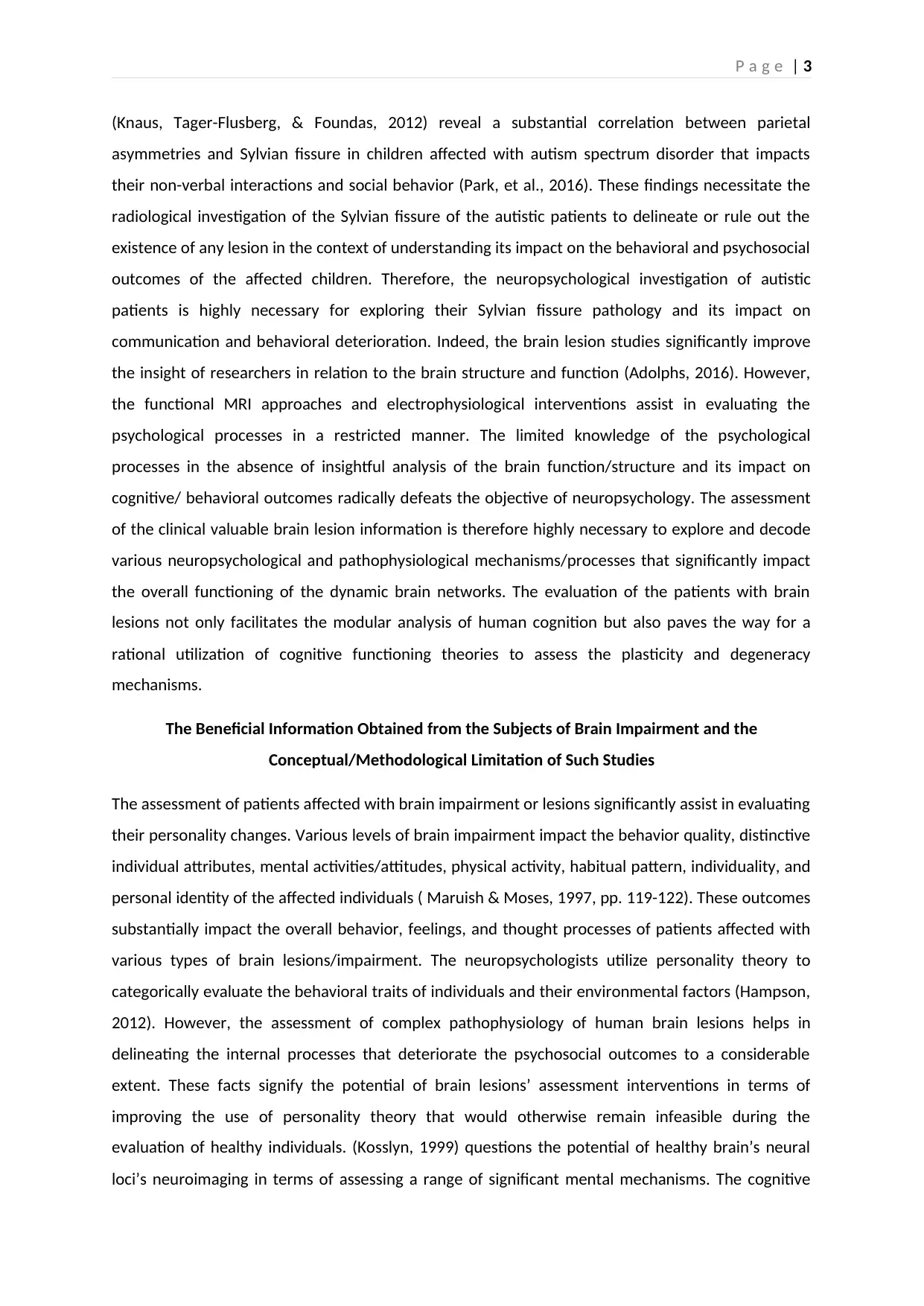
P a g e | 3
(Knaus, Tager-Flusberg, & Foundas, 2012) reveal a substantial correlation between parietal
asymmetries and Sylvian fissure in children affected with autism spectrum disorder that impacts
their non-verbal interactions and social behavior (Park, et al., 2016). These findings necessitate the
radiological investigation of the Sylvian fissure of the autistic patients to delineate or rule out the
existence of any lesion in the context of understanding its impact on the behavioral and psychosocial
outcomes of the affected children. Therefore, the neuropsychological investigation of autistic
patients is highly necessary for exploring their Sylvian fissure pathology and its impact on
communication and behavioral deterioration. Indeed, the brain lesion studies significantly improve
the insight of researchers in relation to the brain structure and function (Adolphs, 2016). However,
the functional MRI approaches and electrophysiological interventions assist in evaluating the
psychological processes in a restricted manner. The limited knowledge of the psychological
processes in the absence of insightful analysis of the brain function/structure and its impact on
cognitive/ behavioral outcomes radically defeats the objective of neuropsychology. The assessment
of the clinical valuable brain lesion information is therefore highly necessary to explore and decode
various neuropsychological and pathophysiological mechanisms/processes that significantly impact
the overall functioning of the dynamic brain networks. The evaluation of the patients with brain
lesions not only facilitates the modular analysis of human cognition but also paves the way for a
rational utilization of cognitive functioning theories to assess the plasticity and degeneracy
mechanisms.
The Beneficial Information Obtained from the Subjects of Brain Impairment and the
Conceptual/Methodological Limitation of Such Studies
The assessment of patients affected with brain impairment or lesions significantly assist in evaluating
their personality changes. Various levels of brain impairment impact the behavior quality, distinctive
individual attributes, mental activities/attitudes, physical activity, habitual pattern, individuality, and
personal identity of the affected individuals ( Maruish & Moses, 1997, pp. 119-122). These outcomes
substantially impact the overall behavior, feelings, and thought processes of patients affected with
various types of brain lesions/impairment. The neuropsychologists utilize personality theory to
categorically evaluate the behavioral traits of individuals and their environmental factors (Hampson,
2012). However, the assessment of complex pathophysiology of human brain lesions helps in
delineating the internal processes that deteriorate the psychosocial outcomes to a considerable
extent. These facts signify the potential of brain lesions’ assessment interventions in terms of
improving the use of personality theory that would otherwise remain infeasible during the
evaluation of healthy individuals. (Kosslyn, 1999) questions the potential of healthy brain’s neural
loci’s neuroimaging in terms of assessing a range of significant mental mechanisms. The cognitive
(Knaus, Tager-Flusberg, & Foundas, 2012) reveal a substantial correlation between parietal
asymmetries and Sylvian fissure in children affected with autism spectrum disorder that impacts
their non-verbal interactions and social behavior (Park, et al., 2016). These findings necessitate the
radiological investigation of the Sylvian fissure of the autistic patients to delineate or rule out the
existence of any lesion in the context of understanding its impact on the behavioral and psychosocial
outcomes of the affected children. Therefore, the neuropsychological investigation of autistic
patients is highly necessary for exploring their Sylvian fissure pathology and its impact on
communication and behavioral deterioration. Indeed, the brain lesion studies significantly improve
the insight of researchers in relation to the brain structure and function (Adolphs, 2016). However,
the functional MRI approaches and electrophysiological interventions assist in evaluating the
psychological processes in a restricted manner. The limited knowledge of the psychological
processes in the absence of insightful analysis of the brain function/structure and its impact on
cognitive/ behavioral outcomes radically defeats the objective of neuropsychology. The assessment
of the clinical valuable brain lesion information is therefore highly necessary to explore and decode
various neuropsychological and pathophysiological mechanisms/processes that significantly impact
the overall functioning of the dynamic brain networks. The evaluation of the patients with brain
lesions not only facilitates the modular analysis of human cognition but also paves the way for a
rational utilization of cognitive functioning theories to assess the plasticity and degeneracy
mechanisms.
The Beneficial Information Obtained from the Subjects of Brain Impairment and the
Conceptual/Methodological Limitation of Such Studies
The assessment of patients affected with brain impairment or lesions significantly assist in evaluating
their personality changes. Various levels of brain impairment impact the behavior quality, distinctive
individual attributes, mental activities/attitudes, physical activity, habitual pattern, individuality, and
personal identity of the affected individuals ( Maruish & Moses, 1997, pp. 119-122). These outcomes
substantially impact the overall behavior, feelings, and thought processes of patients affected with
various types of brain lesions/impairment. The neuropsychologists utilize personality theory to
categorically evaluate the behavioral traits of individuals and their environmental factors (Hampson,
2012). However, the assessment of complex pathophysiology of human brain lesions helps in
delineating the internal processes that deteriorate the psychosocial outcomes to a considerable
extent. These facts signify the potential of brain lesions’ assessment interventions in terms of
improving the use of personality theory that would otherwise remain infeasible during the
evaluation of healthy individuals. (Kosslyn, 1999) questions the potential of healthy brain’s neural
loci’s neuroimaging in terms of assessing a range of significant mental mechanisms. The cognitive
⊘ This is a preview!⊘
Do you want full access?
Subscribe today to unlock all pages.

Trusted by 1+ million students worldwide

P a g e | 4
reserve theory advocates the need for evaluating the brain reserve of individuals in the context of
determining their brain pathology tolerance level. The cognitive aging theory is widely utilized to
evaluate several mental health disruptions in patients affected with age-related conditions like
dementia and Alzheimer’s disease (Stern, Cognitive reserve in aging and Alzheimer's disease, 2012).
However, these interventions fail to evaluate the detailed pathology of various brain lesions and
their significant impact on human behavior and cognition. The assessment of personality factors,
cognitively stimulating behaviors, and lifestyle factors in the absence of brain pathology evaluation
leads to several knowledge gaps in neuropsychological research. The deterioration of various
functional and cognitive tasks’ processing in the human brain reciprocates with the type, location,
and severity of respective brain lesions. The brain pathology significantly impacts the neural reserve
and neural compensation mechanisms that radically impacts the overall mental health, including
behavior and cognition as well as the disease coping capacity of the affected patients (Stern, 2009).
These evidence-based outcomes reveal the requirement of brain pathology/lesion assessment to
radically enhance the effectiveness, utilization, and outcomes of the cognitive reserve theory in
neuropsychological studies for the human population.
Various brain lesion studies assist in evaluating the critical functions, dietary factors, and
comorbidity risk of individuals that would otherwise be impossible to identify through the
assessment of a healthy brain. For example, the study by indicated a linear relationship pattern
between brain lesion volume and calcium-containing diet in elderly patients. Furthermore, the brain
lesion volume reciprocates with significant comorbidities including stroke, dementia, cognitive
decline, depression, and physical disability. Therefore, the evaluation of brain lesion’s volume assists
in identifying the need for reducing the calcium intake level to minimize the risk of adverse
neuropsychological outcomes in elderly patients (Payne, McQuoid, Steffens, & Anderson, 2014). The
patients affected with prefrontal cortex lesions lose their capacity for utilizing the localized
contextual information (Fogelson, Shah, Scabini, & Knight, 2009). Resultantly, they exhibit an
inadequate response time based on the induction of visual stimuli prior to the occurrence of the
target episode. The neuropsychological assessment of this critical information processing function is
never possible through the evaluation of individuals with a healthy brain. These findings again affirm
the significance of assessing the brain lesions and associated neuropsychological outcomes in the
brain-impaired patients.
Patients affected with traumatic brain injury variably experience mental health issues, cognitive
deficits, and activity limitations probably due to the heterogeneity of their background (Rabinowitz
& Levin, 2014). This variation in the functional deficits is rarely explained by the structural and
functional assessment of the traumatic brain lesions. The scientific community needs to conduct
reserve theory advocates the need for evaluating the brain reserve of individuals in the context of
determining their brain pathology tolerance level. The cognitive aging theory is widely utilized to
evaluate several mental health disruptions in patients affected with age-related conditions like
dementia and Alzheimer’s disease (Stern, Cognitive reserve in aging and Alzheimer's disease, 2012).
However, these interventions fail to evaluate the detailed pathology of various brain lesions and
their significant impact on human behavior and cognition. The assessment of personality factors,
cognitively stimulating behaviors, and lifestyle factors in the absence of brain pathology evaluation
leads to several knowledge gaps in neuropsychological research. The deterioration of various
functional and cognitive tasks’ processing in the human brain reciprocates with the type, location,
and severity of respective brain lesions. The brain pathology significantly impacts the neural reserve
and neural compensation mechanisms that radically impacts the overall mental health, including
behavior and cognition as well as the disease coping capacity of the affected patients (Stern, 2009).
These evidence-based outcomes reveal the requirement of brain pathology/lesion assessment to
radically enhance the effectiveness, utilization, and outcomes of the cognitive reserve theory in
neuropsychological studies for the human population.
Various brain lesion studies assist in evaluating the critical functions, dietary factors, and
comorbidity risk of individuals that would otherwise be impossible to identify through the
assessment of a healthy brain. For example, the study by indicated a linear relationship pattern
between brain lesion volume and calcium-containing diet in elderly patients. Furthermore, the brain
lesion volume reciprocates with significant comorbidities including stroke, dementia, cognitive
decline, depression, and physical disability. Therefore, the evaluation of brain lesion’s volume assists
in identifying the need for reducing the calcium intake level to minimize the risk of adverse
neuropsychological outcomes in elderly patients (Payne, McQuoid, Steffens, & Anderson, 2014). The
patients affected with prefrontal cortex lesions lose their capacity for utilizing the localized
contextual information (Fogelson, Shah, Scabini, & Knight, 2009). Resultantly, they exhibit an
inadequate response time based on the induction of visual stimuli prior to the occurrence of the
target episode. The neuropsychological assessment of this critical information processing function is
never possible through the evaluation of individuals with a healthy brain. These findings again affirm
the significance of assessing the brain lesions and associated neuropsychological outcomes in the
brain-impaired patients.
Patients affected with traumatic brain injury variably experience mental health issues, cognitive
deficits, and activity limitations probably due to the heterogeneity of their background (Rabinowitz
& Levin, 2014). This variation in the functional deficits is rarely explained by the structural and
functional assessment of the traumatic brain lesions. The scientific community needs to conduct
Paraphrase This Document
Need a fresh take? Get an instant paraphrase of this document with our AI Paraphraser
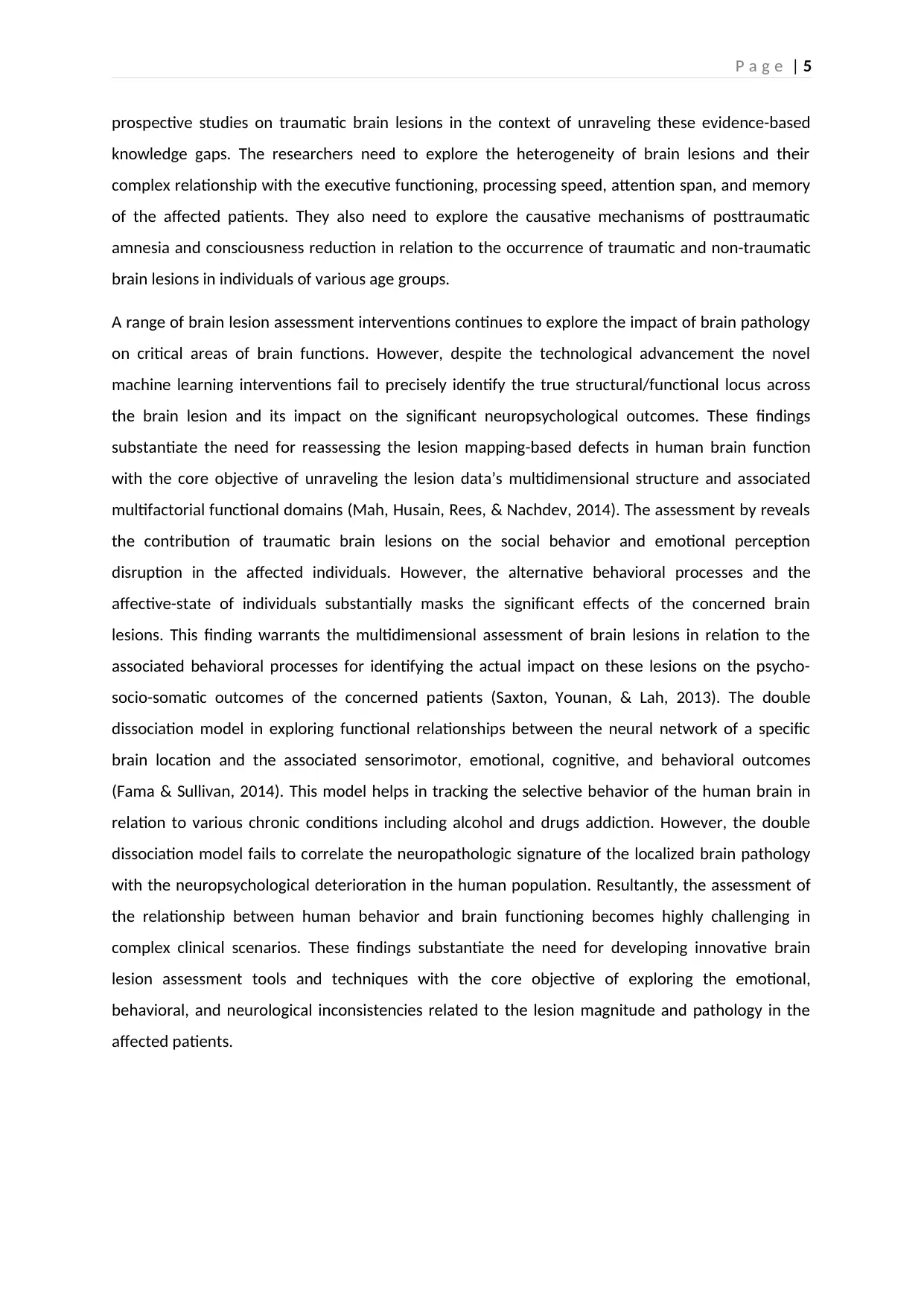
P a g e | 5
prospective studies on traumatic brain lesions in the context of unraveling these evidence-based
knowledge gaps. The researchers need to explore the heterogeneity of brain lesions and their
complex relationship with the executive functioning, processing speed, attention span, and memory
of the affected patients. They also need to explore the causative mechanisms of posttraumatic
amnesia and consciousness reduction in relation to the occurrence of traumatic and non-traumatic
brain lesions in individuals of various age groups.
A range of brain lesion assessment interventions continues to explore the impact of brain pathology
on critical areas of brain functions. However, despite the technological advancement the novel
machine learning interventions fail to precisely identify the true structural/functional locus across
the brain lesion and its impact on the significant neuropsychological outcomes. These findings
substantiate the need for reassessing the lesion mapping-based defects in human brain function
with the core objective of unraveling the lesion data’s multidimensional structure and associated
multifactorial functional domains (Mah, Husain, Rees, & Nachdev, 2014). The assessment by reveals
the contribution of traumatic brain lesions on the social behavior and emotional perception
disruption in the affected individuals. However, the alternative behavioral processes and the
affective-state of individuals substantially masks the significant effects of the concerned brain
lesions. This finding warrants the multidimensional assessment of brain lesions in relation to the
associated behavioral processes for identifying the actual impact on these lesions on the psycho-
socio-somatic outcomes of the concerned patients (Saxton, Younan, & Lah, 2013). The double
dissociation model in exploring functional relationships between the neural network of a specific
brain location and the associated sensorimotor, emotional, cognitive, and behavioral outcomes
(Fama & Sullivan, 2014). This model helps in tracking the selective behavior of the human brain in
relation to various chronic conditions including alcohol and drugs addiction. However, the double
dissociation model fails to correlate the neuropathologic signature of the localized brain pathology
with the neuropsychological deterioration in the human population. Resultantly, the assessment of
the relationship between human behavior and brain functioning becomes highly challenging in
complex clinical scenarios. These findings substantiate the need for developing innovative brain
lesion assessment tools and techniques with the core objective of exploring the emotional,
behavioral, and neurological inconsistencies related to the lesion magnitude and pathology in the
affected patients.
prospective studies on traumatic brain lesions in the context of unraveling these evidence-based
knowledge gaps. The researchers need to explore the heterogeneity of brain lesions and their
complex relationship with the executive functioning, processing speed, attention span, and memory
of the affected patients. They also need to explore the causative mechanisms of posttraumatic
amnesia and consciousness reduction in relation to the occurrence of traumatic and non-traumatic
brain lesions in individuals of various age groups.
A range of brain lesion assessment interventions continues to explore the impact of brain pathology
on critical areas of brain functions. However, despite the technological advancement the novel
machine learning interventions fail to precisely identify the true structural/functional locus across
the brain lesion and its impact on the significant neuropsychological outcomes. These findings
substantiate the need for reassessing the lesion mapping-based defects in human brain function
with the core objective of unraveling the lesion data’s multidimensional structure and associated
multifactorial functional domains (Mah, Husain, Rees, & Nachdev, 2014). The assessment by reveals
the contribution of traumatic brain lesions on the social behavior and emotional perception
disruption in the affected individuals. However, the alternative behavioral processes and the
affective-state of individuals substantially masks the significant effects of the concerned brain
lesions. This finding warrants the multidimensional assessment of brain lesions in relation to the
associated behavioral processes for identifying the actual impact on these lesions on the psycho-
socio-somatic outcomes of the concerned patients (Saxton, Younan, & Lah, 2013). The double
dissociation model in exploring functional relationships between the neural network of a specific
brain location and the associated sensorimotor, emotional, cognitive, and behavioral outcomes
(Fama & Sullivan, 2014). This model helps in tracking the selective behavior of the human brain in
relation to various chronic conditions including alcohol and drugs addiction. However, the double
dissociation model fails to correlate the neuropathologic signature of the localized brain pathology
with the neuropsychological deterioration in the human population. Resultantly, the assessment of
the relationship between human behavior and brain functioning becomes highly challenging in
complex clinical scenarios. These findings substantiate the need for developing innovative brain
lesion assessment tools and techniques with the core objective of exploring the emotional,
behavioral, and neurological inconsistencies related to the lesion magnitude and pathology in the
affected patients.
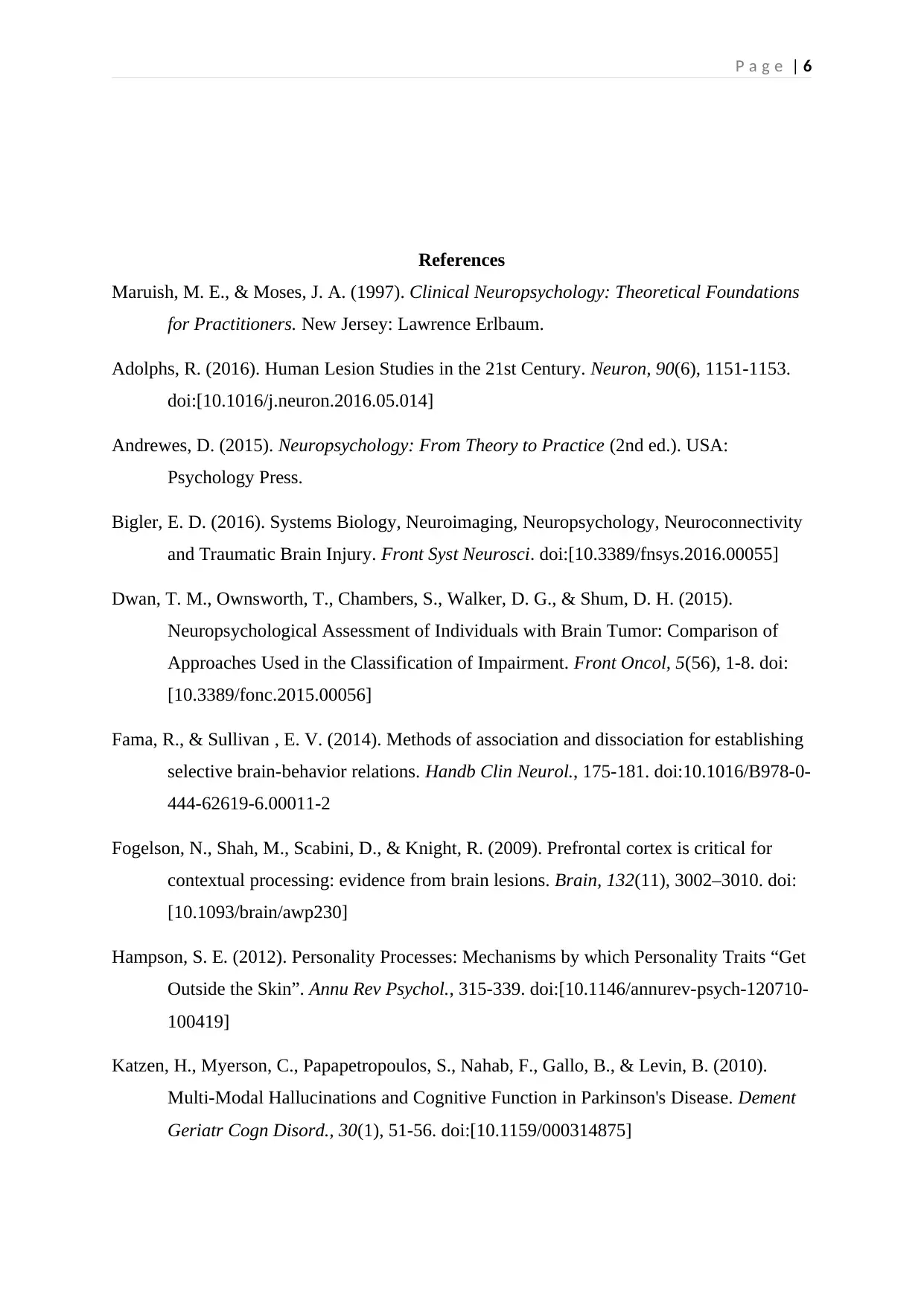
P a g e | 6
References
Maruish, M. E., & Moses, J. A. (1997). Clinical Neuropsychology: Theoretical Foundations
for Practitioners. New Jersey: Lawrence Erlbaum.
Adolphs, R. (2016). Human Lesion Studies in the 21st Century. Neuron, 90(6), 1151-1153.
doi:[10.1016/j.neuron.2016.05.014]
Andrewes, D. (2015). Neuropsychology: From Theory to Practice (2nd ed.). USA:
Psychology Press.
Bigler, E. D. (2016). Systems Biology, Neuroimaging, Neuropsychology, Neuroconnectivity
and Traumatic Brain Injury. Front Syst Neurosci. doi:[10.3389/fnsys.2016.00055]
Dwan, T. M., Ownsworth, T., Chambers, S., Walker, D. G., & Shum, D. H. (2015).
Neuropsychological Assessment of Individuals with Brain Tumor: Comparison of
Approaches Used in the Classification of Impairment. Front Oncol, 5(56), 1-8. doi:
[10.3389/fonc.2015.00056]
Fama, R., & Sullivan , E. V. (2014). Methods of association and dissociation for establishing
selective brain-behavior relations. Handb Clin Neurol., 175-181. doi:10.1016/B978-0-
444-62619-6.00011-2
Fogelson, N., Shah, M., Scabini, D., & Knight, R. (2009). Prefrontal cortex is critical for
contextual processing: evidence from brain lesions. Brain, 132(11), 3002–3010. doi:
[10.1093/brain/awp230]
Hampson, S. E. (2012). Personality Processes: Mechanisms by which Personality Traits “Get
Outside the Skin”. Annu Rev Psychol., 315-339. doi:[10.1146/annurev-psych-120710-
100419]
Katzen, H., Myerson, C., Papapetropoulos, S., Nahab, F., Gallo, B., & Levin, B. (2010).
Multi-Modal Hallucinations and Cognitive Function in Parkinson's Disease. Dement
Geriatr Cogn Disord., 30(1), 51-56. doi:[10.1159/000314875]
References
Maruish, M. E., & Moses, J. A. (1997). Clinical Neuropsychology: Theoretical Foundations
for Practitioners. New Jersey: Lawrence Erlbaum.
Adolphs, R. (2016). Human Lesion Studies in the 21st Century. Neuron, 90(6), 1151-1153.
doi:[10.1016/j.neuron.2016.05.014]
Andrewes, D. (2015). Neuropsychology: From Theory to Practice (2nd ed.). USA:
Psychology Press.
Bigler, E. D. (2016). Systems Biology, Neuroimaging, Neuropsychology, Neuroconnectivity
and Traumatic Brain Injury. Front Syst Neurosci. doi:[10.3389/fnsys.2016.00055]
Dwan, T. M., Ownsworth, T., Chambers, S., Walker, D. G., & Shum, D. H. (2015).
Neuropsychological Assessment of Individuals with Brain Tumor: Comparison of
Approaches Used in the Classification of Impairment. Front Oncol, 5(56), 1-8. doi:
[10.3389/fonc.2015.00056]
Fama, R., & Sullivan , E. V. (2014). Methods of association and dissociation for establishing
selective brain-behavior relations. Handb Clin Neurol., 175-181. doi:10.1016/B978-0-
444-62619-6.00011-2
Fogelson, N., Shah, M., Scabini, D., & Knight, R. (2009). Prefrontal cortex is critical for
contextual processing: evidence from brain lesions. Brain, 132(11), 3002–3010. doi:
[10.1093/brain/awp230]
Hampson, S. E. (2012). Personality Processes: Mechanisms by which Personality Traits “Get
Outside the Skin”. Annu Rev Psychol., 315-339. doi:[10.1146/annurev-psych-120710-
100419]
Katzen, H., Myerson, C., Papapetropoulos, S., Nahab, F., Gallo, B., & Levin, B. (2010).
Multi-Modal Hallucinations and Cognitive Function in Parkinson's Disease. Dement
Geriatr Cogn Disord., 30(1), 51-56. doi:[10.1159/000314875]
⊘ This is a preview!⊘
Do you want full access?
Subscribe today to unlock all pages.

Trusted by 1+ million students worldwide

P a g e | 7
Kesler, S. R., Adams , H. F., Blasey, C. M., & Bigler , E. D. (2003). Premorbid intellectual
functioning, education, and brain size in traumatic brain injury: an investigation of the
cognitive reserve hypothesis. Appl Neuropsychol., 10(3), 153-62. Retrieved from
https://www.ncbi.nlm.nih.gov/pubmed/12890641
Knaus, T. A., Tager-Flusberg, H., & Foundas , A. L. (2012). Sylvian Fissure and Parietal
Anatomy in Children with Autism Spectrum Disorder. Behav Neurol., 327-339. doi:
[10.3233/BEN-2012-110214]
Kosslyn, S. M. (1999). If neuroimaging is the answer, what is the question? Philos Trans R
Soc Lond B Biol Sci, 354((1387)), 1283–1294. doi:[10.1098/rstb.1999.0479]
Mah, Y. H., Husain, M., Rees, G., & Nachdev, P. (2014). Human brain lesion-deficit
inference remapped. Brain, 137(9), 2522-2531. doi:[10.1093/brain/awu164]
Noll, K. R., & Fardell, J. E. (2015). Commentary: “Neuropsychological Assessment of
Individuals with Brain Tumor: Comparison of Approaches Used in the Classification
of Impairment”. Front Oncol., 1-2. doi:[10.3389/fonc.2015.00188]
Park, H. R., Lee, J. M., Moon, H. E., Lee, D. S., Kim, B. N., Kim, J., . . . Paek, S. H. (2016).
A Short Review on the Current Understanding of Autism Spectrum Disorders. Exp
Neurobiol, 25(1), 1-13. doi: [10.5607/en.2016.25.1.1]
Payne, M. E., McQuoid, D. R., Steffens, D. C., & Anderson, J. J. (2014). Elevated brain
lesion volumes in older adults who use calcium supplements: a cross sectional clinical
observational study. Br J Nutr., 112(2), 220-227. doi:[10.1017/S0007114514000828]
Rabinowitz, A. R., & Levin, H. S. (2014). Cognitive Sequelae of Traumatic Brain Injury.
Psychiatr Clin North Am, 37(1), 1-11. doi:[10.1016/j.psc.2013.11.004]
Saxton, M. E., Younan , S. S., & Lah, S. (2013). Social behaviour following severe traumatic
brain injury: contribution of emotion perception deficits. NeuroRehabilitation, 263-
271. doi:10.3233/NRE-130954.
Shinn, A. K., Baker, J. T., Cohen, B. M., & Öngür, D. (2013). Functional Connectivity of
Left Heschl’s Gyrus in Vulnerability to Auditory Hallucinations in Schizophrenia.
Schizophr Res, 143(2-3), 260-268. doi:[10.1016/j.schres.2012.11.037]
Stern, Y. (2009). Cognitive Reserve. Neuropsychologia, 47(10), 2015–2028.
doi:[10.1016/j.neuropsychologia.2009.03.004]
Kesler, S. R., Adams , H. F., Blasey, C. M., & Bigler , E. D. (2003). Premorbid intellectual
functioning, education, and brain size in traumatic brain injury: an investigation of the
cognitive reserve hypothesis. Appl Neuropsychol., 10(3), 153-62. Retrieved from
https://www.ncbi.nlm.nih.gov/pubmed/12890641
Knaus, T. A., Tager-Flusberg, H., & Foundas , A. L. (2012). Sylvian Fissure and Parietal
Anatomy in Children with Autism Spectrum Disorder. Behav Neurol., 327-339. doi:
[10.3233/BEN-2012-110214]
Kosslyn, S. M. (1999). If neuroimaging is the answer, what is the question? Philos Trans R
Soc Lond B Biol Sci, 354((1387)), 1283–1294. doi:[10.1098/rstb.1999.0479]
Mah, Y. H., Husain, M., Rees, G., & Nachdev, P. (2014). Human brain lesion-deficit
inference remapped. Brain, 137(9), 2522-2531. doi:[10.1093/brain/awu164]
Noll, K. R., & Fardell, J. E. (2015). Commentary: “Neuropsychological Assessment of
Individuals with Brain Tumor: Comparison of Approaches Used in the Classification
of Impairment”. Front Oncol., 1-2. doi:[10.3389/fonc.2015.00188]
Park, H. R., Lee, J. M., Moon, H. E., Lee, D. S., Kim, B. N., Kim, J., . . . Paek, S. H. (2016).
A Short Review on the Current Understanding of Autism Spectrum Disorders. Exp
Neurobiol, 25(1), 1-13. doi: [10.5607/en.2016.25.1.1]
Payne, M. E., McQuoid, D. R., Steffens, D. C., & Anderson, J. J. (2014). Elevated brain
lesion volumes in older adults who use calcium supplements: a cross sectional clinical
observational study. Br J Nutr., 112(2), 220-227. doi:[10.1017/S0007114514000828]
Rabinowitz, A. R., & Levin, H. S. (2014). Cognitive Sequelae of Traumatic Brain Injury.
Psychiatr Clin North Am, 37(1), 1-11. doi:[10.1016/j.psc.2013.11.004]
Saxton, M. E., Younan , S. S., & Lah, S. (2013). Social behaviour following severe traumatic
brain injury: contribution of emotion perception deficits. NeuroRehabilitation, 263-
271. doi:10.3233/NRE-130954.
Shinn, A. K., Baker, J. T., Cohen, B. M., & Öngür, D. (2013). Functional Connectivity of
Left Heschl’s Gyrus in Vulnerability to Auditory Hallucinations in Schizophrenia.
Schizophr Res, 143(2-3), 260-268. doi:[10.1016/j.schres.2012.11.037]
Stern, Y. (2009). Cognitive Reserve. Neuropsychologia, 47(10), 2015–2028.
doi:[10.1016/j.neuropsychologia.2009.03.004]
Paraphrase This Document
Need a fresh take? Get an instant paraphrase of this document with our AI Paraphraser

P a g e | 8
Stern, Y. (2012). Cognitive reserve in ageing and Alzheimer's disease. Lancet Neurol.,
11(11), 1006–1012. doi:[10.1016/S1474-4422(12)70191-6]
Warren, D. E., Power, J. D., Bruss, J., Denburg, N. L., Waldron, E. J., Sun, H., . . . Tranel, D.
(2014). Network measures predict neuropsychological outcome after brain injury.
Proc Natl Acad Sci U S A, 111(39), 14247–14252. doi:[10.1073/pnas.1322173111]
Stern, Y. (2012). Cognitive reserve in ageing and Alzheimer's disease. Lancet Neurol.,
11(11), 1006–1012. doi:[10.1016/S1474-4422(12)70191-6]
Warren, D. E., Power, J. D., Bruss, J., Denburg, N. L., Waldron, E. J., Sun, H., . . . Tranel, D.
(2014). Network measures predict neuropsychological outcome after brain injury.
Proc Natl Acad Sci U S A, 111(39), 14247–14252. doi:[10.1073/pnas.1322173111]
1 out of 8
Your All-in-One AI-Powered Toolkit for Academic Success.
+13062052269
info@desklib.com
Available 24*7 on WhatsApp / Email
![[object Object]](/_next/static/media/star-bottom.7253800d.svg)
Unlock your academic potential
Copyright © 2020–2025 A2Z Services. All Rights Reserved. Developed and managed by ZUCOL.

